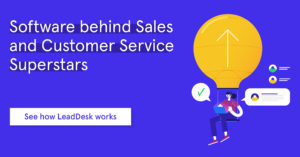6 Outbound Metrics to Help Your Agents Close More
Looking to close deals cost-efficiently? Take a look at our blog on the 6 vital outbound metrics that turn your contact center into a gold mine.
schedule5 minute read
The future of outbound is based on data. Nearly every aspect of contact center operations can be measured and the data used to drive results and help agents work more efficiently.
Many metrics are worth monitoring, but there are a few that are essential for successful outbound campaigns. To help you optimize your operation, we’ve compressed our full list of call and contact center metrics to the six key outbound metrics (in alphabetical order) that help your agents close deals like never before.
1) Contact rate
Getting in touch with leads is one of the fundamentals in outbound campaigns. Contact rate indicates the percentage of calls that actually lead to human contact.
To avoid spending resources on unanswered calls and contacts, there are some measures you can take:
- Use high-quality contact lists. Every unanswered call is a waste of resources.
- Schedule your calls to match your leads’ schedule. Don’t call an elementary school teacher in the middle of the day or a bartender in the evening.
- Even though leaving voicemail rarely results in call-backs, making a good offer via voicemail can lead to the person answering your call the next time.
Statistically, as many as 50% of customers do not answer their phone, so you have to remember that it’s also a quantity game. You should use automatic dialing to make as many calls as possible.
2) Closing rate / conversion rate / success rate
Even though reaching people is vital, there’s no gain if you can’t close the deals efficiently. It is important to do everything you can to make your agents close as much as possible, and the conversion rate indicates your success. It is the percentage of contacts that reach a campaign goal: donation, sale, meeting, etc.
You can calculate the conversion rate by dividing the number of conversions by the number of contacts reached and multiplying by 100.
To improve your conversion rate, consider the following tips:
- Train your agents so their pitches are perfect and up to date
- Keep the pitches short and on point
- Standardize the pitches using A/B testing and careful analysis
- Use CRMs to build sales funnels
- Create an atmosphere of trust and solidarity between your agents
- Incentivize good performance to motivate agents.
Finally, try to hire people persons. Your agents spend their working hours on the phone with strangers. It’s hard to realize your potential as an agent if you don’t like human contact.
3) Hit rate
The most crucial aspect of outbound campaigns is reaching as many potential customers and closing as many of them as possible. Along with conversion rate (see above), hit rate is an efficient way to get data on how your contact list and agents are performing.
Essentially, hit rate indicates the ratio between closed deals and closed contacts. A closed deal accomplishes a campaign goal, which can be anything from contracts to appointments. Closed contacts, on the other hand, are the leads that have been reached but will not be called again during the ongoing campaign.
Let’s assume your agent makes 100 calls a day. 40 of them are not answered, but 60 of them are. This leaves your agent with 60 opportunities to close a deal. Out of the 60 contacts, 45 decline your agent’s offer and 15 produce a sale. By dividing 15 with 45 you get a hit rate of 0.33 or 33.3%.
Hit rate offers valuable insight into your agent or team performance as well as the quality of your list. If the overall hit rate is low, your agents could benefit from additional training or they require contact lists that are better in tune with the offering. If your hit rate is high while your contact rate is low, you will either need better contact lists or to bulk up the volume of your calls
If there are big individual differences between your agents, standardizing work methods could be the answer.
4) First call close
First call close is sometimes called the home run of outbound operations. It indicates the percentage of calls where a successful deal is made on the first contact with a lead.
Closing deals during the first call enables agents to generate revenue faster. The first contact with a customer is statistically the best time to close the deal, as call-backs don’t perform as well. High percentage in first call close also reduces agent churn, as agents making good commission are less likely to leave the company.
To improve first call close, you should identify the trends that allow your agents to close at a high rate. Analyse the success factors behind first call closes and standardize your process so all agents have the same tools for success. You should also consider incentivizing first call close.
5) Revenue per (call, hour, day, week)
Whatever your outbound operation works on, ultimately the goal is to generate revenue or create value. Measuring the incoming revenue is usually done on an hourly, daily and weekly basis along with single calls.
Good revenue per call alone isn’t enough if the calls take too long and too few calls are made in total. It’s also worth comparing the revenue generated by different campaigns, teams and agents to learn what could be improved.
Knowing the amount of revenue each call generates is key to all aspects of running a call center. Without this knowledge, planning future operations is almost impossible, as you should always adjust your budget based on expenditure and revenue. Comparing revenue and cost of calls gives you a good overview of the success of your business.
6) Cost per (call, hours, day, week)
While you monitor the money coming in, you also have to keep a close watch on expenditure if you want to turn a profit. Costs are usually measured per call, hourly, daily and weekly and you can either focus on the big picture or individual campaigns or agents.
When you measure the costs of running an outbound operation, you have to include staff costs, computers, software, office space, phones and other overhead costs. When you have the sum of total expenditures during a specific timeframe, you simply divide that sum by the number of calls, hours, days or weeks.
Remember that getting costs down is just one side of the coin. Your agents need a proper work environment to close deals. You have to carefully consider if cutting costs is profitable. Sometimes rising call volumes bring additional costs, but checking cost per call gives you a good idea whether there’s room for concern.
Looking for more outbound metrics? To unravel all the possibilities of optimizing contact center operations, read our Complete Guide to Call Center Metrics.
Interested in inbound tips? Take a look at our top 5 inbound metrics.

